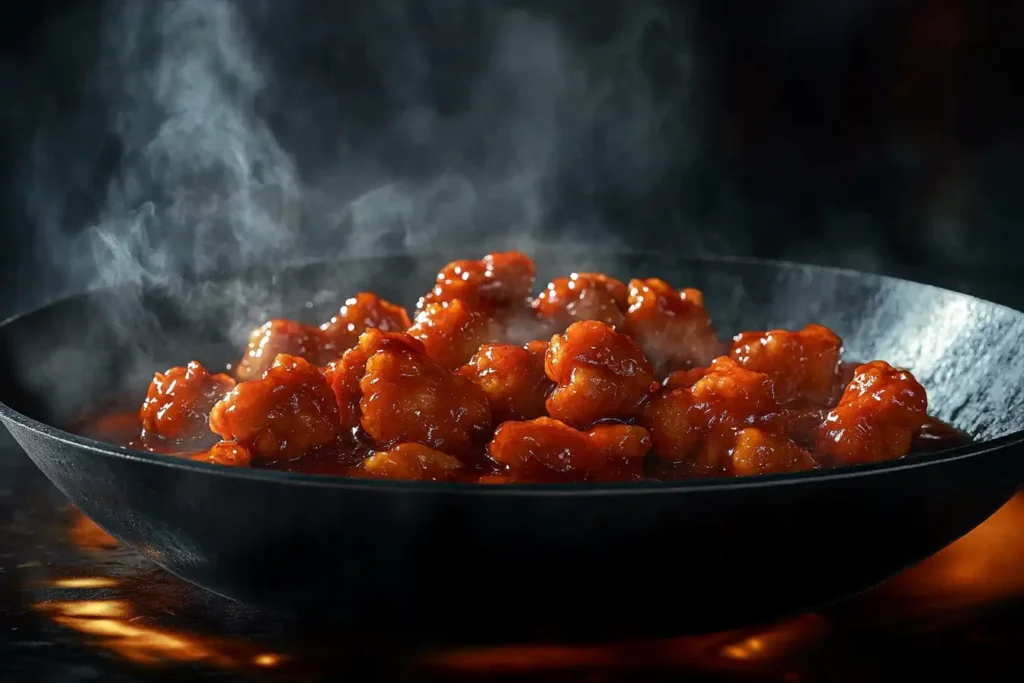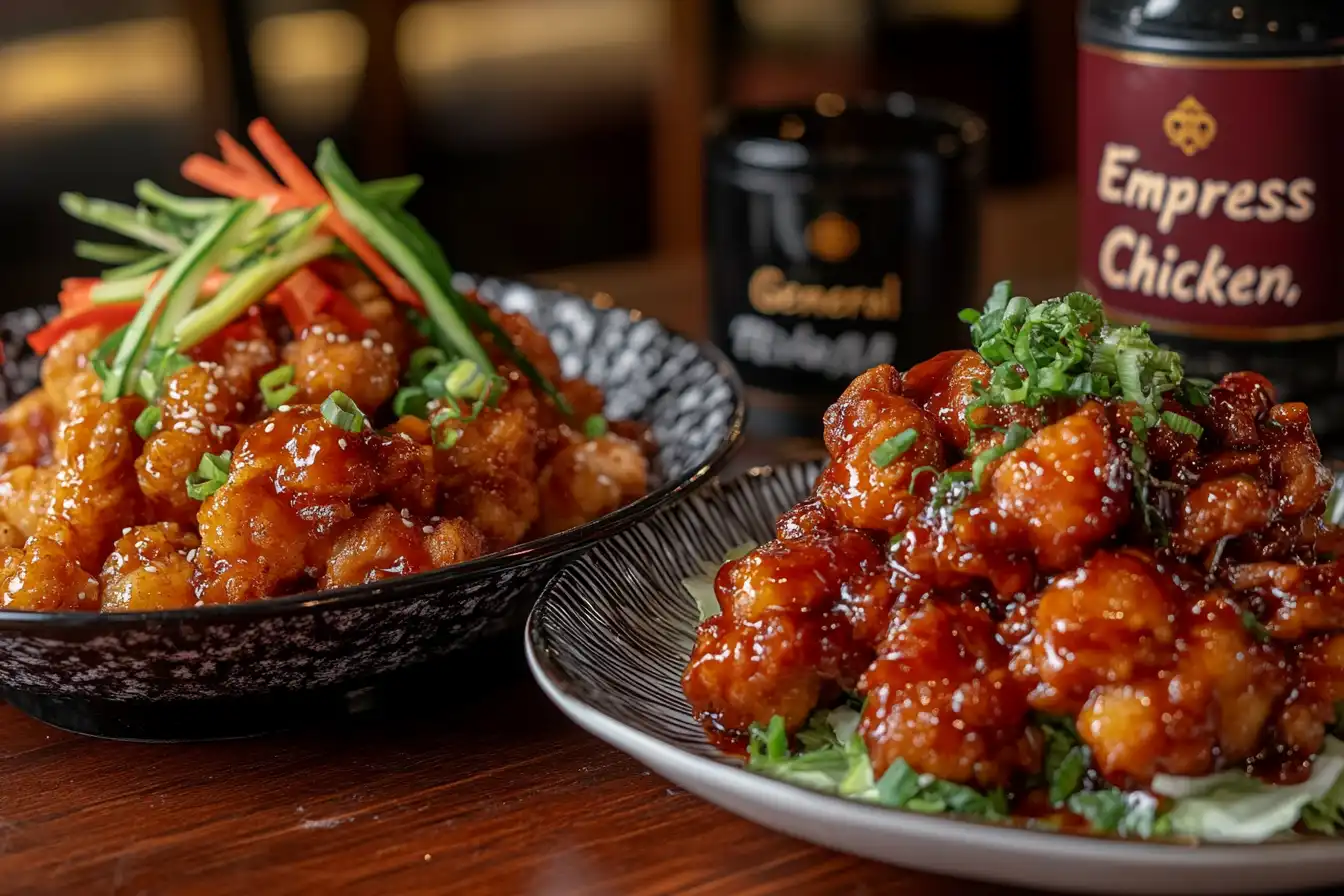Chinese-American cuisine has become a staple on restaurant menus worldwide, offering an incredible mix of flavors that balance sweet, spicy, tangy, and savory. Among the most popular dishes are Empress Chicken and General Tso’s Chicken, both known for their bold flavors and unique preparation styles. But what truly sets these dishes apart?
This article dives deep into their ingredients, cooking methods, flavor profiles, and cultural significance. By the end, you’ll know exactly how to distinguish between these iconic dishes and decide which one suits your taste buds. Let’s explore these two culinary marvels, starting with an overview.
Introduction to Empress Chicken and General Tso’s Chicken
What are Empress Chicken and General Tso’s Chicken?
Empress Chicken and General Tso’s Chicken are two iconic dishes often associated with Chinese-American cuisine, but they are distinct in several ways. Empress Chicken boasts a spicier and slightly more traditional flavor, while General Tso’s Chicken leans toward sweet and tangy notes with a crispy exterior. Both are typically served as entrées, accompanied by rice or noodles, making them a favorite for takeout and home dining alike.
A Brief History of the Dishes
The origins of these dishes differ significantly. General Tso’s Chicken is believed to have been inspired by a Hunanese general but gained its popularity as a Westernized dish in the 20th century. On the other hand, Empress Chicken has roots in authentic Chinese cuisine, often linked to imperial flavors that focus on rich, spicy profiles.
Popularity and Regional Variations
While General Tso’s Chicken enjoys global recognition and is a cornerstone of Chinese takeout menus, Empress Chicken is less ubiquitous, often considered a hidden gem on specialized menus. Regional variations exist, with some chefs tweaking spice levels or sweetening the sauces to suit local palates.
Key Differences in Ingredients
Primary Protein: White Meat vs. Mixed Meat
One of the most noticeable distinctions between these two dishes lies in the type of chicken used. Empress Chicken is almost always prepared with white meat, prized for its tenderness and lean quality. Meanwhile, General Tso’s Chicken often features a mix of white and dark meat, giving it a slightly richer and more robust flavor. This difference impacts the texture and taste of the final dish, making each unique.
When pondering what is the difference between Empress Chicken and General Tso’s Chicken, the protein source is a standout factor. Those who prefer leaner chicken may lean toward Empress Chicken, while others may enjoy the depth provided by dark meat in General Tso’s.
Sauces: Spicy, Tangy, and Sweet Profiles
The sauces are another major distinction. Empress Chicken is known for its spicy and savory sauce, which often includes ingredients like chili paste, garlic, soy sauce, and ginger. In contrast, General Tso’s Chicken has a sweeter and tangier profile, featuring a blend of sugar, vinegar, hoisin sauce, and a touch of heat from dried chilies.
Interestingly, both sauces balance sweetness and spice, but General Tso’s is more approachable for those with a sweet tooth. On the other hand, Empress Chicken caters to spice lovers.
Vegetables and Garnishes Used in Each Dish
Vegetables and garnishes add another layer of difference. Empress Chicken is typically paired with simple stir-fried vegetables, like bell peppers or onions, complementing its bold sauce. General Tso’s Chicken often comes with steamed broccoli or carrots, adding a pop of color and mild sweetness.
By combining specific proteins, sauces, and garnishes, these dishes deliver a distinct dining experience. Let’s next explore how preparation techniques set them apart.
Cooking Techniques and Preparation
Breaded vs. Non-Breaded Chicken
Another crucial distinction in what is the difference between Empress Chicken and General Tso’s Chicken is the preparation of the chicken itself. General Tso’s Chicken is usually battered and deep-fried, resulting in a crispy exterior that holds up well against its thick, glossy sauce. On the flip side, Empress Chicken often skips heavy breading, allowing the chicken to soak up its spicy sauce directly.
This variation affects the overall texture: General Tso’s delivers a crunchy bite, while Empress Chicken offers a smoother, saucier experience.
Frying and Sauce Integration

The cooking method for these dishes also varies. In General Tso’s Chicken, the fried pieces are tossed in a wok with its signature sweet and tangy sauce until fully coated. This creates a sticky, flavorful glaze that clings to the chicken.
For Empress Chicken, the sauce is typically cooked separately and poured over the chicken, which may be stir-fried or lightly sautéed. This approach allows the bold flavors of the sauce to shine without overshadowing the chicken’s natural taste.
Traditional vs. Modern Preparation Methods
While both dishes have traditional roots, modern adaptations have emerged to cater to different preferences. Health-conscious versions of General Tso’s Chicken may involve air-frying instead of deep-frying, and some chefs opt for baked or grilled chicken for Empress Chicken. These variations provide options for diverse dietary needs while preserving their iconic flavors.
By now, the cooking techniques should give a clearer picture of how these dishes are crafted. Next, we’ll break down their flavor profiles to highlight how they delight the palate.
Flavor Profiles and Taste
Spiciness of Empress Chicken
When discussing what is the difference between Empress Chicken and General Tso’s Chicken, flavor is one of the most notable distinctions. Empress Chicken delivers a bold, spicy kick, often enhanced with chili paste and garlic. The heat is balanced with a savory undertone that appeals to those who love a strong, fiery flavor. It’s not just about the spice; there’s a depth to the sauce that sets it apart.
Tangy and Sweet Notes in General Tso’s Chicken
On the other hand, General Tso’s Chicken is known for its tangy sweetness. A combination of sugar, vinegar, and soy sauce creates a harmonious balance that’s both comforting and indulgent. This sweetness, paired with a hint of spice from dried chilies, makes General Tso’s a crowd-pleaser, especially for those new to Chinese-American dishes.
Comparing Overall Flavor Experiences
The flavors of these dishes cater to different preferences. Empress Chicken is perfect for spice enthusiasts seeking a hearty, rich meal. Meanwhile, General Tso’s Chicken appeals to diners looking for a sweeter, tangier experience with a subtle spicy undertone. Both dishes are flavorful in their own right, but their distinct profiles ensure there’s something for everyone.
For more delicious chicken recipes, check out our guide to cooking chicken in different styles.
Nutritional Comparison
Calorie Counts and Fat Content
Nutritionally, there’s a significant difference in calorie content. General Tso’s Chicken is often higher in calories due to its breaded and deep-fried preparation. The frying process adds extra fat, making it a more indulgent choice. In contrast, Empress Chicken typically avoids heavy breading, resulting in a lighter dish with fewer calories.
Carbohydrates and Sugar Levels in Sauces
Another key factor is the sauce. General Tso’s Chicken contains more sugar, contributing to its sweet flavor but also increasing the carbohydrate content. Conversely, Empress Chicken’s spicy sauce is often lower in sugar, focusing instead on bold, savory, and spicy notes.
Protein Content and Healthier Alternatives
Both dishes provide a good amount of protein, but the type of chicken used can affect the nutritional profile. Since Empress Chicken is generally made with white meat, it’s leaner and higher in protein compared to the mixed meat often used in General Tso’s Chicken. For healthier alternatives, baked or air-fried versions of these dishes can reduce fat content significantly.
For more health-conscious recipes, explore our tips for making chicken pieces tender.
Cultural and Culinary Context
The Role of Empress Chicken in Chinese-American Cuisine
When exploring what is the difference between Empress Chicken and General Tso’s Chicken, understanding their cultural background provides valuable insight. Empress Chicken has deep roots in Chinese cuisine, often showcasing traditional flavors and preparation techniques. Its bold, spicy sauce reflects the fiery taste profiles of regions like Sichuan and Hunan. While not as widely recognized as its counterpart, it remains a beloved dish for those seeking an authentic experience.
The Fame and Misconceptions of General Tso’s Chicken
General Tso’s Chicken, on the other hand, is a true product of Chinese-American fusion. Despite its origins being loosely tied to Hunanese cuisine, the version we know today was tailored to suit Western palates. Its sweeter sauce and fried, crispy chicken helped it quickly gain popularity in the U.S., making it a takeout staple. However, many diners assume it is authentically Chinese, which highlights the power of cultural adaptation in food.
Influence of Western Adaptations on Both Dishes
Western adaptations have influenced both dishes, with chefs adjusting spice levels, sweetness, and cooking techniques to cater to diverse audiences. For example, General Tso’s Chicken often features vibrant broccoli florets as a side, a choice designed to appeal to health-conscious diners. Meanwhile, Empress Chicken retains a more traditional presentation, offering a closer link to its Chinese origins.
How to Choose Between the Two?
When to Choose Empress Chicken
If you enjoy bold, spicy flavors and prefer dishes that focus on savory notes, Empress Chicken is the way to go. Its light preparation method and simple garnish make it a great choice for spice enthusiasts or anyone seeking a leaner alternative. Plus, its authentic flavors provide a culinary connection to traditional Chinese cooking.
When General Tso’s Chicken Might Be Better
General Tso’s Chicken is ideal for those who love a crispy, sweet, and tangy dish. Its fried coating gives it a satisfying crunch, and the sticky sauce appeals to diners looking for a balance of flavors. If you’re trying Chinese-American cuisine for the first time, General Tso’s is often a safe, crowd-pleasing option.
Considerations for Dietary Preferences
Your choice may also depend on dietary needs. While General Tso’s Chicken is richer and higher in calories, Empress Chicken offers a lighter, protein-packed alternative. If you’re looking for healthier variations, both dishes can be adapted using air-frying or grilling methods to reduce fat content.
Ultimately, the decision between these dishes depends on your flavor preferences and dietary priorities, but either option is sure to delight!
FAQs About Empress Chicken and General Tso’s Chicken
What is the difference between Empress Chicken and General Tso’s Chicken?
This is a common question for anyone exploring Chinese-American cuisine. The main differences lie in their flavor profiles, cooking methods, and ingredients. Empress Chicken is spicier and made with white meat, while General Tso’s Chicken is sweeter and often includes both white and dark meat. Their sauces also differ, with General Tso’s being tangy and sticky, and Empress Chicken offering bold heat.
Is Empress Chicken Always Spicier?
Yes, Empress Chicken is generally spicier due to its use of chili paste and savory seasonings. However, spice levels can vary depending on the chef or restaurant.
Can You Use Dark Meat for Empress Chicken?
While Empress Chicken traditionally uses white meat, dark meat can be substituted. It adds richness and moisture but may slightly alter the dish’s overall taste.
Are These Dishes Available Worldwide?
Yes, but General Tso’s Chicken is far more common internationally, particularly in Chinese takeout menus.
Conclusion – Choosing Your Favorite
Finding Your Flavor
When deciding what is the difference between Empress Chicken and General Tso’s Chicken, it boils down to personal taste. Empress Chicken shines with its spicy, bold flavors, while General Tso’s Chicken caters to those who love sweetness balanced with a touch of heat.
Exploring Both Options
Why choose just one? Both dishes showcase unique elements of Chinese-American cuisine, making them worth trying at least once. You can explore healthier versions or stick with the classics to enjoy their authentic flavors.
Whether you prefer the fiery kick of Empress Chicken or the satisfying crunch of General Tso’s Chicken, these dishes are sure to become favorites in your dining repertoire.
For more recipes and tips, explore our guide to cooking chicken in different styles.

